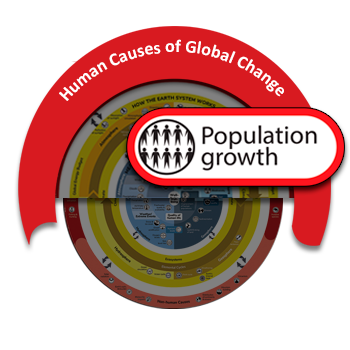Population growth is the increase in the number of humans on Earth. For most of human history our population size was relatively stable. But with innovation and industrialization, energy, food, water, and medical care became more available and reliable. Consequently, global human population rapidly increased, and continues to do so, with dramatic impacts on global climate and ecosystems. We will need technological and social innovation to help us support the world’s population as we adapt to and mitigate climate and environmental changes.

World human population growth from 10,000 BC to 2019 AD. Data from: The United Nations
Human population growth impacts the Earth system in a variety of ways, including:
- Increasing the extraction of resources from the environment. These resources include fossil fuels (oil, gas, and coal), minerals, trees, water, and wildlife, especially in the oceans. The process of removing resources, in turn, often releases pollutants and waste that reduce air and water quality, and harm the health of humans and other species.
- Increasing the burning of fossil fuels for energy to generate electricity, and to power transportation (for example, cars and planes) and industrial processes.
- Increase in freshwater use for drinking, agriculture, recreation, and industrial processes. Freshwater is extracted from lakes, rivers, the ground, and man-made reservoirs.
- Increasing ecological impacts on environments. Forests and other habitats are disturbed or destroyed to construct urban areas including the construction of homes, businesses, and roads to accommodate growing populations. Additionally, as populations increase, more land is used for agricultural activities to grow crops and support livestock. This, in turn, can decrease species populations, geographic ranges, biodiversity, and alter interactions among organisms.
- Increasing fishing and hunting, which reduces species populations of the exploited species. Fishing and hunting can also indirectly increase numbers of species that are not fished or hunted if more resources become available for the species that remain in the ecosystem.
- Increasing the transport of invasive species, either intentionally or by accident, as people travel and import and export supplies. Urbanization also creates disturbed environments where invasive species often thrive and outcompete native species. For example, many invasive plant species thrive along strips of land next to roads and highways.
- The transmission of diseases. Humans living in densely populated areas can rapidly spread diseases within and among populations. Additionally, because transportation has become easier and more frequent, diseases can spread quickly to new regions.
Can you think of additional cause and effect relationships between human population growth and other parts of the Earth system?
Visit the burning of fossil fuels, agricultural activities, and urbanization pages to learn more about how processes and phenomena related to the size and distribution of human populations affect global climate and ecosystems.
Investigate
Learn more in these real-world examples, and challenge yourself to construct a model that explains the Earth system relationships.
